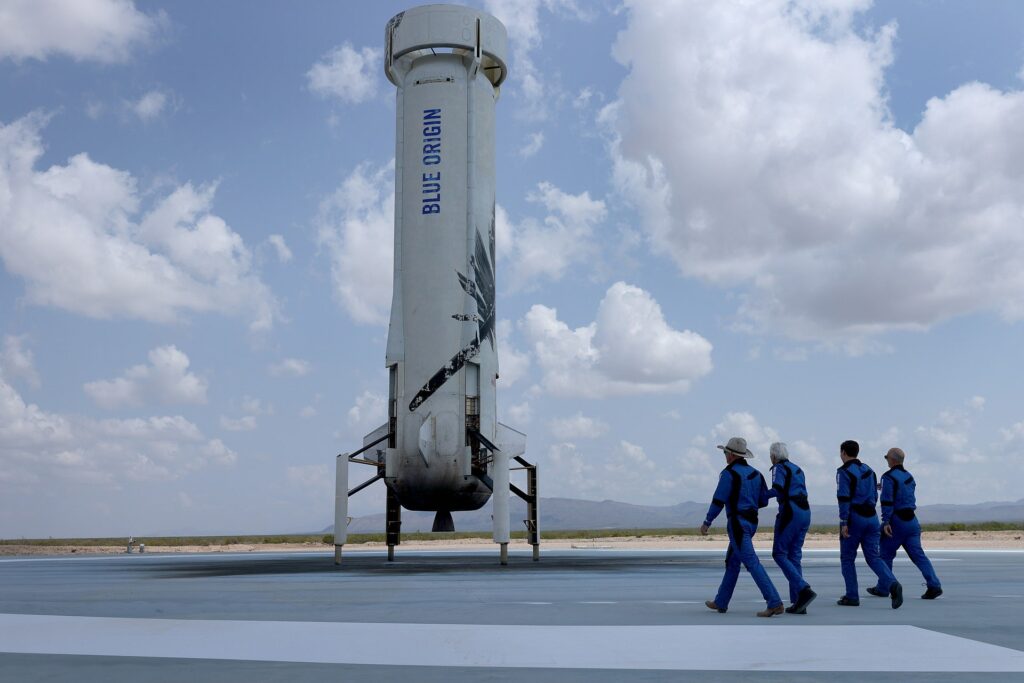
On July 20, 2021, New Shepard, the first crewed voyager spacecraft, took flight from a private launch facility in Van Horn, Texas, at 14:12 British Summer Time (BST), i.e., 18:42 Indian Standard Time (IST). The capsule broke from its rocket two minutes into the journey and proceeded to the Kármán Line — the most commonly recognised border of space, which reaches 100 kilometres or 62 miles aloft. After the New Shepard mission that took them more than 3,51,000 feet in the air and back, Jeff Bezos, Oliver Daemen, Wally Funk, and Mark Bezos safely evacuated the capsule. “Best day ever!” were Mr Bezos’ words as the capsule landed on completing a 10-minute, 10-second journey.
Origin and the Primary Aim of the Idea
“You don’t pick your passions; your passions pick you,” says Jeff Bezos. And it was space that drew him in at such an early age. He sat captivated as a 5-year-old boy, watching the Apollo 11 moon landing in 1969. He was a great “Star Trek” enthusiast as a kid, binge-watching episodes over and again. In high school, he read Gerard O’Neill’s book “High Frontier,” which suggested that instead of colonising another planet, people could live in massive space stations — a concept Bezos has pushed forward for years. Drawing inspiration from “October Sky,” a film based on Homer Hickam’s biography “Rocket Boys,” he created Blue Origin in 2000, and now considers it his most important work. Bezos terms the money he has accumulated from Amazon as the “lottery ticket” that enables the funding of Blue Origin by investing $1 billion annually.
The New Shepard spacecraft, developed by Bezos’ firm Blue Origin, is aimed at the booming space tourism sector. Mr Bezos, the founder of Amazon, and other “billionaire space race” competitors have been chastised for creating what some perceive as “fun rides” for the affluent. Critics argue that the funds might be used to increase employee wages or combat climate change. The Amazon CEO, on the other hand, has a green vision — “We need to take all heavy industry, all polluting industry and move it into space, and keep the Earth as this beautiful gem of a planet that it is,” Bezos told MSNBC.
Flight Profile
The New Shepard system honours Mercury astronaut Alan Shepard — the first American to go to space in 1962. Before July 20, 2021, the rocket completed 15 uncrewed tests of which the most recent was on April 14, when it launched on an astronaut rehearsal trip. It stands around 60 feet or 18 metres tall and is meant to launch passengers into suborbital space for a three-minute “weightless” period.
Blue Origin’s rocket ranch, located 200 miles out in the West Texas desert, is an isolated launch location surrounded by dense vegetation and harsh mountains, far from civilisation. On the day of launch, New Shepard’s capsule was propelled to Mach 3 (three times the speed of sound) by the rocket’s engines, which burned for over two and a half minutes. According to Blue Origin, the capsule then disintegrated, enabling the four-person crew to float around and soak in the sights of the Earth below and the cosmos beyond via the largest windows ever seen in space. The capsule dropped back into the Texas desert after reaching apogee, or the highest point. It landed softly under a trio of parachutes along with a cushion of air produced by a brief retro-thruster burst.
Wearing a cowboy hat, the Amazon CEO was the first to emerge through the hatch. As television cameras shot images, the rest of the team followed, hugging family members and celebrating on the ground. They then exploded champagne bottles to commemorate the historic achievement, which Gary Lai, Blue Origin’s senior director, characterised as “picture perfect.”
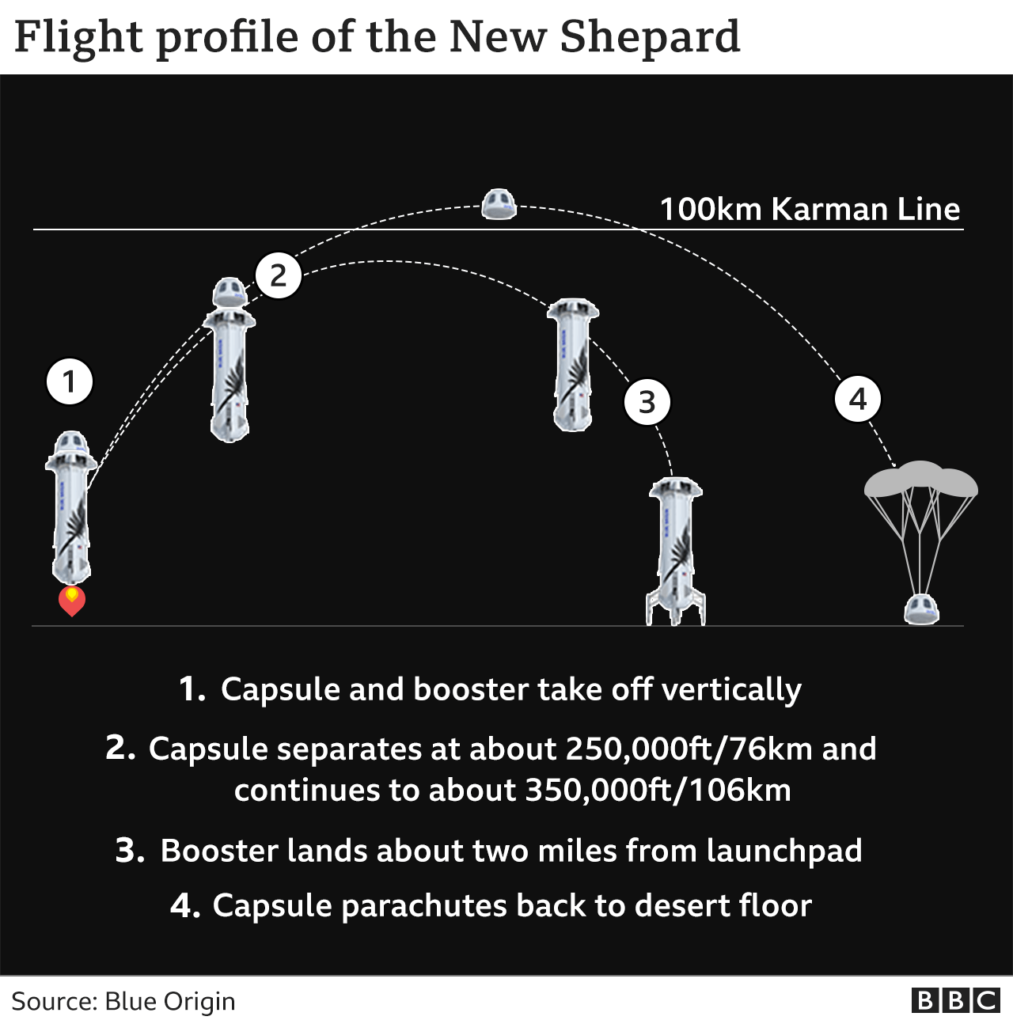
The Crew
The four passengers in Blue Origin’s spacecraft — Jezz Bezos, the world’s wealthiest person, Mark Bezos, his brother, Wally Funk, an 82-year-old space pioneer, and Oliver Daemen, an 18-year-old student — all come from different walks of life. What’s more fascinating? The crew comprised the youngest and the oldest passengers in the history of space travel.
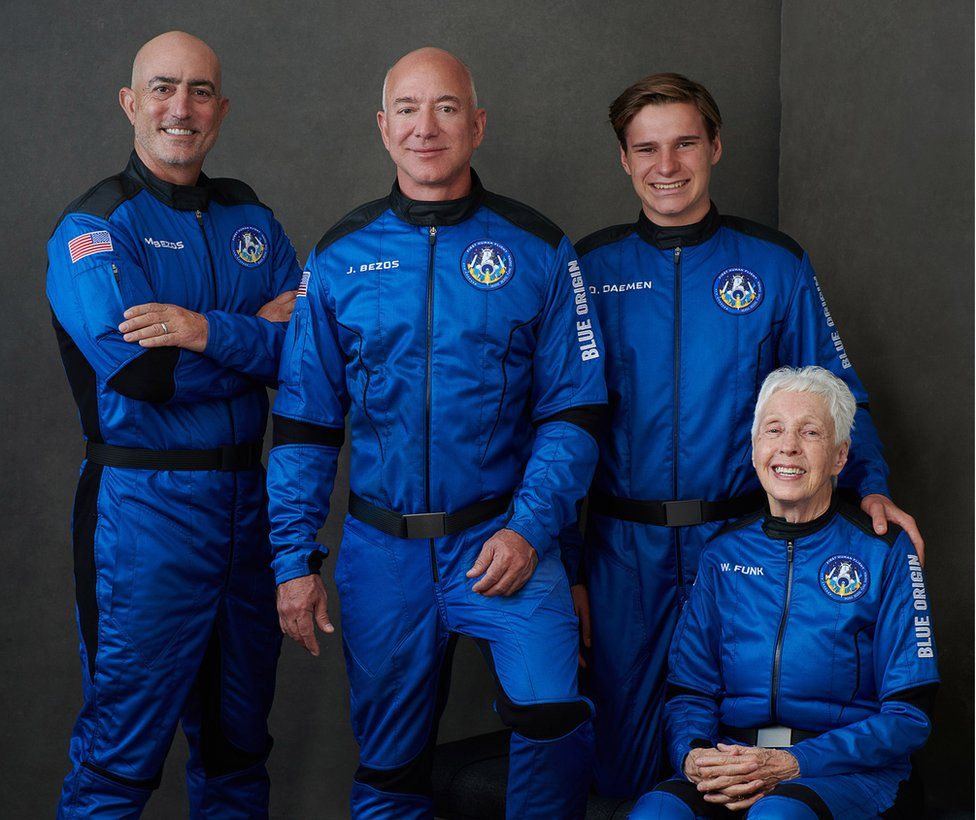
Jeff Bezos is an American business mogul, and according to Forbes, has a net worth of over $200 billion. Mark Bezos, Jeff Bezos’ brother, is the senior vice president of a New York-based charity organisation called Robin Hood. Oliver Daemen, the youngest passenger, is a Dutch financier’s son. He had initially reserved a seat on the second flight but was called in to replace an anonymous public auction winner who had to cancel the trip with Bezos. Ms Funk, the oldest passenger, was a member of the Mercury 13 — a group of women formed in the 1960s. They were subjected to the same screening procedures as male astronauts but were never selected for the US national space programme. Funk went on to have a groundbreaking career as an aviator, flying over 20,000 hours in various planes. She was the National Transportation Safety Board’s first female air safety investigator and the Federal Aviation Administration’s first female inspector.
Not So Thankful Amazon Employees
After his successful flight to suborbital space, Bezos’ in his speech during a press conference, said, “I want to thank every Amazon employee and every Amazon customer because you guys paid for all of this”.
His remarks were met with sharp criticism. One Amazon employee from Indiana went on to state that, “I guess he’s thanking us for putting the money in his pocket to do so by our hard work, sacrificing our bonuses and stock options to make it possible”. Hourly warehouse employees of Amazon are not eligible for stock options or bonuses.
But the criticism for Bezos’ and Blue Origin started in July when he announced that he would be flying on Blue Origin’s first passenger spaceflight. There was even a petition put up on change.org, which garnered 165,000 signatures to prevent the world’s richest man from coming back to Earth. It was started as a joke by Ric Geiger, who knew that the title could spread a message of wealth inequality.
He’s Not the First and He Won’t Be the Last
Bezos’ is not the only billionaire to go to space in recent times. A week before Bezos made his trip to space, entrepreneur and founder of the Virgin Group, 71-year-old Richard Branson, took a trip to the edge of space aboard his winged rocket ship called SpaceShipTwo Unity. He was accompanied by a crew of 5, including two pilots, Dave Mackay and Michael Masucci, and three company employees, Sirisha Bandla, Colin Bennett and Beth Moses.
SpaceShipTwo reached an altitude of around 88 kilometres over the New Mexico desert, which was enough to experience three to four minutes of weightlessness and view the curvature of the Earth. It then safely glided back.
After landing back on Earth during his speech, Branson congratulated his team and said, “Seventeen years of hard work to get us this far.”
While the original “Space Race” was a 20th-century competition between the Soviet Union and the United States to be superior in spaceflight capability, today’s “Space Race” is between billionaires trying to provide the best space travel experience to those who can afford it.
Bezos and Branson are not the only ones to enter the space travel industry. Elon Musk, founder, CEO, and Chief Engineer at SpaceX, has also offered similar transportation services.
After its successful mission, Virgin Galactic launched a $500 million share offering, only to suffer an 8% dip after the launch of New Shepard. USB estimates that space tourism will be a $3 billion market by 2030.
Future Plans for Blue Origin
Blue Origin hasn’t disclosed how much future flights on New Shepard will cost the general populace. It claimed on its live feed before Tuesday’s debut that it received numerous requests and gave premium rates for the first flights to individuals who participated in the auction. However, a suborbital space tourism industry is only one of Blue Origin’s numerous initiatives to realise Bezos’ long-term vision of a future involving “millions of people living and working in space.”
New Shepard is the first in a series of projects that Blue Origin is working on. The firm is also developing New Glenn, a considerably larger rocket. It generates almost 4 million pounds of thrust at sea level, fueled by seven Blue Engine 4 (BE-4) engines that burn liquid oxygen and liquefied natural gas. The rocket was meant to launch last year, but due to some challenges, the firm claims that it won’t launch until late 2022. Moreover, Blue Origin is working with Northrop Grumman, Draper, and Lockheed Martin to build a lunar lander — a spaceship that would transport humans to and from the Moon’s surface.
The Environmental Aspect
It is estimated that every rocket launch produces up to 300 tons of carbon dioxide into the upper atmosphere, where it can remain for years. With the expected boom in space tourism, the environmental impact is going to be substantial.
Jessica Dallas, a senior policy adviser at the New Zealand Space Agency, conducted an analysis on space launch emissions that was published last year and wrote that the most studied and immediate environmental repercussion of launching space vehicles is the depletion of the stratospheric ozone.
During an interview, Bezos stated that all “polluting industries” must be moved to space to preserve Earth and its environment. This comes as reports of New Shepard fuel being relatively less polluting compared to the others.
This comes at a time when Musk has said that the SpaceX Starships are capable of cleaning debris in Earth’s orbit.
There have also been people who have pointed out that instead of spending money on space exploration and transport, billionaires should invest in protecting and preserving our planet.
Although the aim of most of these companies is to make space more accessible to people, only time will tell if they are here to provide wings to the dreams of people or to fuel the desires of a select class of individuals who are rich enough to afford what currently seems like a luxury. With many more companies throwing their hat into the ring, one thing is for sure — the space travel industry will be an exciting one to look out for.
Written by Cynthia Maria Dsouza and Suhani Kabra for MTTN
Featured image by Vogue
Image Source: BBC, Twitter, Business Insider
Sources: The Washington Post, The Hindu, Business Insider, CNBC, The Guardian, BBC
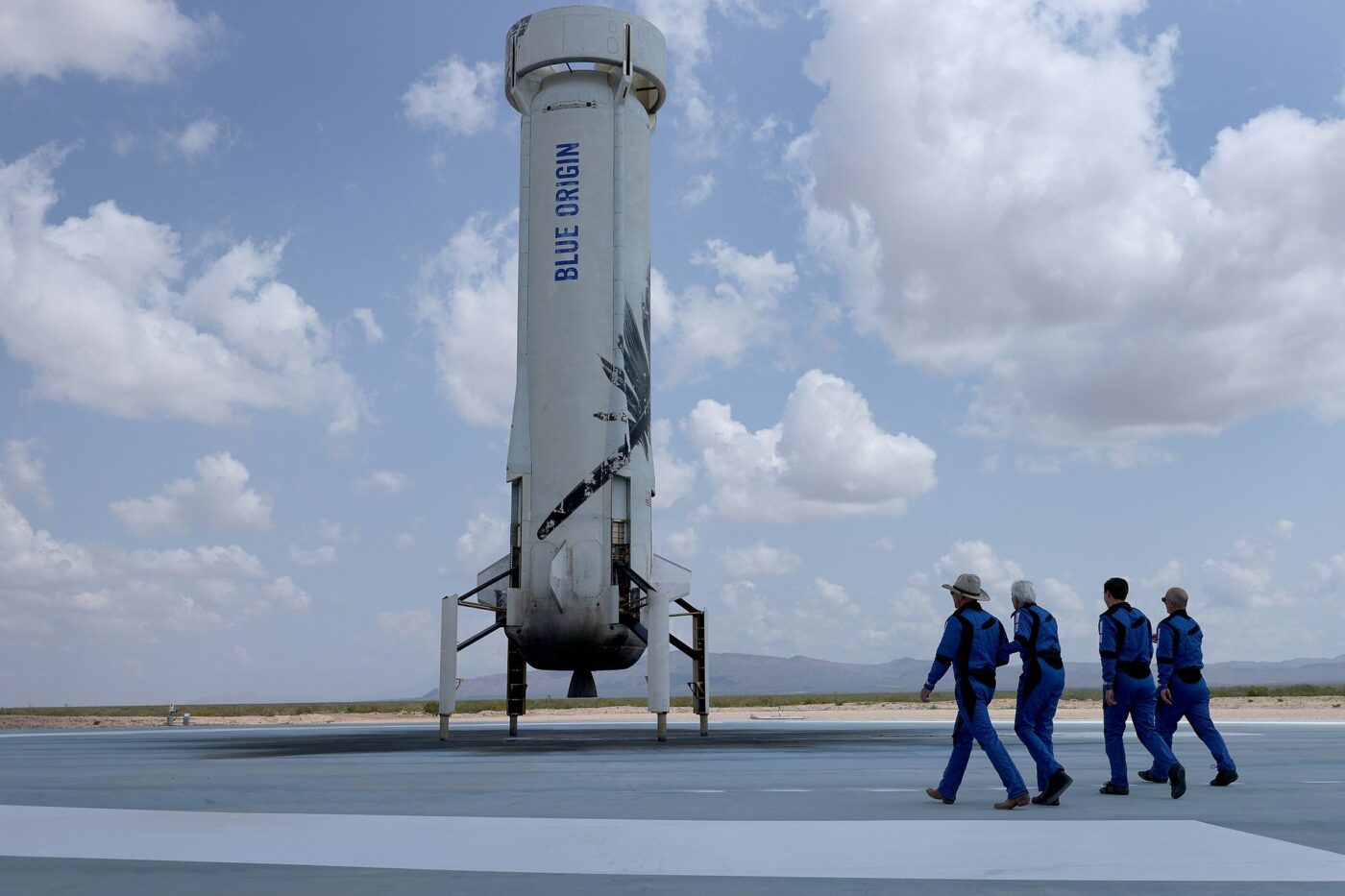
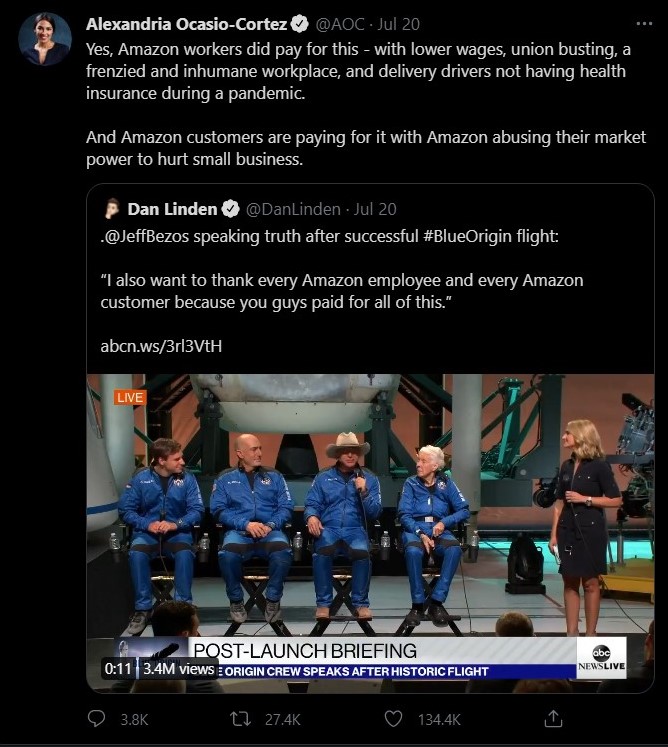

Leave a Reply
You must be logged in to post a comment.